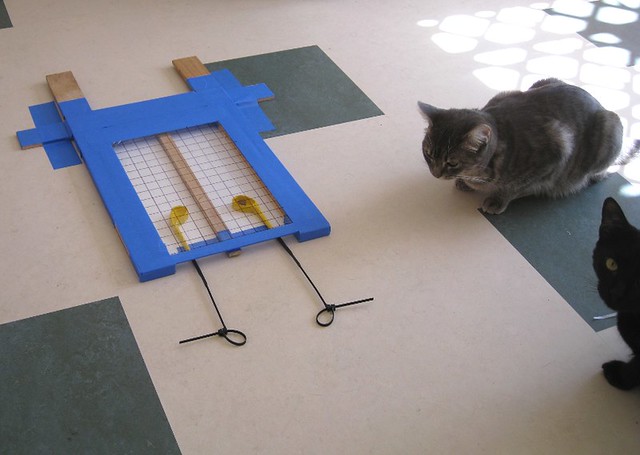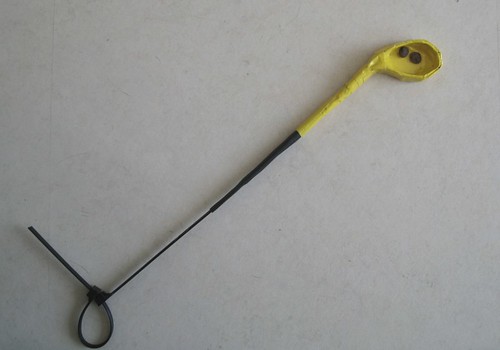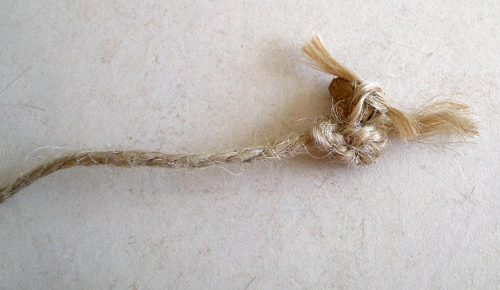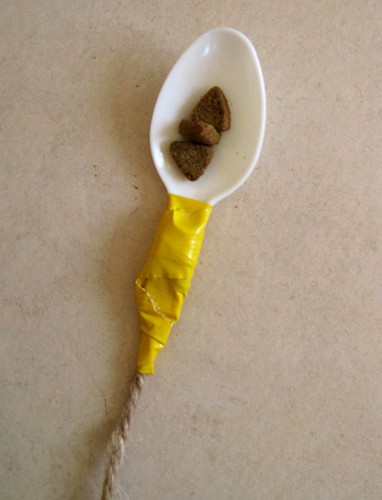
My post referencing the 2009 cat-cognition study noted that:
(a) Most of the popular articles regarding that study made what looked to me like unwarranted interpretive leaps (sadly not much of a surprise there these days), and
(b) While the study itself read as more "neutrally investigative" and data-focused than the popular articles, it did not seem as if the experimental setup necessarily accounted for feline sensory modalities, and hence may not have permitted a true test of the cats' cognitive capacities in the area of physical causality.
So, in light of item (b) above, and in light of the fact that I had all the necessary components on hand to create a setup similar to that used in the aforementioned study, I decided to see if my own feline housemates might be interested in trying their hand (or rather, paw) at some string-pulling.
Of course I am not aiming to present my own "results" as Real Scientific Data; they were, after all, quite informally obtained from a tiny sample set. At the absolute most, observations presented herein might represent a sort of "proof of concept", i.e., how setups could be improved in future experiments to increase the likelihood of meaningful results. Overall, though, I mainly did this for fun -- for me, and for the cats!
BACKGROUND
Four cats were offered the opportunity to participate in this activity:
(1) Brodie
DOB: 15 August, 2009 (approx)
SEX: Male (neutered)
ANCESTRY: Domestic shorthair
(2) Coraline
DOB: 15 August, 2009 (approx)
SEX: Female (spayed)
ANCESTRY: Domestic shorthair
(3) Shadow
DOB: 15 August, 2009 (approx)
SEX: Male (neutered)
ANCESTRY: Domestic shorthair
(4) Nikki
DOB: 28 October, 2001
SEX: Female (spayed)
ANCESTRY: Siamese (Chocolate Point)
The three younger cats (Coraline, Brodie, and Shadow) were littermates, born into a feral colony. I adopted them when they were between 7 and 10 weeks of age. The elder cat (Nikki) is unrelated to the others, was born into a cattery, and lived with my parents until early 2010.
All four cats had lived with me for at least six months prior to the experiment, and since the experiment took place in my' home, they did not have to acclimate to an unfamiliar environment beforehand.
PREDICTIONS
Predictions going into the experiment were as follows:
(1) At least one cat (of the four) would demonstrate both motivation and ability to complete at least one task case successfully.
(2) Performance (in motivated cats) would improve when the treats were made more visually obvious, i.e., via use of color and size contrast.
(3) Performance might improve if a less flexible medium (i.e., plastic zip ties rather than string) was used, as this would provide faster feedback to the cats regarding their efforts and would be less likely to induce distraction (cats often find strings, and their movements, extremely interesting in their own right).
SETUP
The setup used in this exercise was based on the description provided by the study1:
The apparatus consisted of a box of base size 49 × 40 cm with clear Perspex walls on three sides and a wire mesh lid. The top of the box hinged off the base to allow access to the inside. The base was made of chipboard with a white plastic surface, and protruded from the box at the front by 9 cm, providing a smooth surface and good contrast for the strings. A 1-cm gap at the base of the front wall allowed the strings to pass from the front accessible end into the inaccessible part of the box. A clear Perspex bridge (base size 11 cm × 6 cm) was used in trials where there are two crossed strings to prevent the strings getting tangled. Every part of the set-up was visible to the cats at any time. The strings were blue rope (∅ 5 mm), with a length of 25 cm (long) and 10 cm (short). Cat treats were attached to the strings to act as rewards for succeeding in the task. The reward for each trial was approximately 10 g of mashed tuna or pilchards, or a small cat biscuit.
Some articles referencing the study also included a photograph of the apparatus used, which I attempted to replicate as closely as possible given available materials.
Main Structure
To make the main structure of the apparatus, I used several pieces of scrap, held together with blue painter's tape in a rectangular "frame" shape. To the bottom side of the frame I attached a sheet of thick white watercolor paper.
To the top side of the frame I attached a piece of Plexiglas with a grid pattern drawn on it -- however, upon closer reading of the study apparatus description (after I'd already completed my experiment), I noted that the original study had used a plain wire mesh on the top of the frame.

(Image showing main structure of test apparatus I built)
This meant that, contrary to my original (incorrect) impression, the cats more than likely would have indeed been able to smell the treats, as wire mesh blocked their physical access to the treats via the top of the box, but not the transmission of odors. If I were to try the experiment again at home I would use a piece of window screen or similar material for the lid of the box, rather than Plexiglas.
Another difference (albeit a deliberate one in this instance) between my setup and the referenced study's setup was the fact that in some trials I employed a central wooden divider that extended the interior length of the box (parallel to its left and right sides).
The purpose of this divider was to prevent the strings or zip tie mechanisms (more on that in a moment) from interfering with each other physically at all during "parallel string" trials, as I saw the potential for distraction if one string ended up touching the other while the cat was pulling on it, etc. However, in practice this divider turned out to be unnecessary, as when I removed it the cats' performance did not change and the strings/zip ties did not get tangled at all.
Treat Delivery Media
I experimented with two primary variables in terms of the treat-delivery media:
(1) Flexibility: In some trials I used actual strings (lengths of very flexible sisal twine), with or without a "treat container" at one end (see below):

In others I used plastic zip ties modified to include a small "cup" on one end to hold treats.

(Image shows one of the zip tie/treat cup mechanisms employed)
(2) Contrast: In the first few trials I used unmodified sisal twine lengths and simply tied a piece of dry cat food or chicken jerky to the end of the treat-carrying piece (see image below, note the lack of visual contrast):

In the second few trials I used yellow "cups" filled with a small amount of dry cat food attached to the ends of plastic zip ties.
In the third round of trials I went back to using the sisal twine, but attached the end of a white plastic spoon as a treat container.

The goal here was to see what, if any, impact visual contrast had on the cats' ability to correctly identify the treat-carrying piece (thus distinguishing it from the "dummy" piece). One major criticism I had of the original study was that (inasmuch as I could tell from the description and photos available) it did not seem as if the treats were sufficiently visible to the cats.
Since, as I noted in my prior post, cats have fairly poor close-range visual acuity for fine details, I surmised that the treat holder needed to be significantly larger/wider than the end of the string (or zip tie) in order for them to be able to distinguish it properly. I also figured that it would be helpful for the treats themselves to stand out color-wise against the background of their container or cup.
TRAINING
I did not employ a formal "training phase" as the study described doing. However, I did present the treat-delivering string and zip tie pieces to the cats for inspection (prior to inserting them into the puzzle box). During this activity some of the string/zip tie pieces contained treats and some did not.
I also left the apparatus on the floor for several hours prior to starting any task trials, so that the cats would be able to investigate it at their leisure and not be distracted by the sheer novelty of the equipment when the task trials began.
RESULTS & DISCUSSION
Participation Variation
Of the four individual cats presented with the test equipment, two (Coraline and Brodie) completed various task cases successfully. Shadow was very interested in watching his siblings but declined to participate himself, and Nikki seemed totally uninterested in the activity.
Having lived with these particular cats for some time now I am not surprised by this outcome, given their respective personalities and predilections; Coraline and Brodie (Coraline especially) have always been the most mechanically inclined of the group, whereas Shadow is more inclined to solicit favors from humans (i.e., he'd rather meow at me to GIVE him a treat than try and get one himself).
Nikki, meanwhile, just tends to operate on an agenda all her own, and while at some point I can see her getting interested in a string puzzle of some sort, she wasn't interested on the day(s) on which I ran trials.
I should note that I do not draw any conclusions (negative or positive) about the non-participant cats' understanding of physical cause and effect based on their non-participation in this particular exercise. Since neither of the non-participants even attempted to complete the task, all I figure is warranted in terms of conclusion is that the materials and situation failed to inspire their interest, which of course says absolutely nothing about their capacity to cogitate about string and its uses.
Social Factors
By "social factors" here I refer to the presence/absence of multiple cats near the apparatus setup during task trials. Initially I tried testing one cat at a time, however, for the younger cats this proved impossible. No single cat would participate or do anything with the apparatus at all when separated (via a closed door in the house) from his or her siblings. Instead, the lone cat would wander around looking for his/her siblings, while the sibling cats would scratch at the door.
Once I let all the cats wander about freely, though, the three younger ones were plenty interested in the apparatus and two of them participated consistently over the course of three days. To me this suggests social factors might be more important to cats (especially related cats who get along well) than many would necessarily suspect. Having all the cats accessing the setup simultaneously did make certain aspects of the experiment more difficult to organize but it was certainly a better situation than zero participation, as I had when I attempted to test a single lone cat at a time.
As for Nikki's non-interest in the setup, social factors may have played a role her as well -- she tolerates the others but does not seem to like being very near them. I may try taking the apparatus out to the patio at some point and seeing if she might show more interest there -- she seems to be a lot more inhibited indoors, will only play with toys in the yard, etc.
Basic Observations
Again, as this was an informal/fun exercise and not an Official Scientific Experiment, I did not keep a precise count of how many times a given cat solved a task -- since I was the sole person setting up and running everything, it was not possible to carefully track every variable. However, I did note whenever a cat was able to solve a particular task case 2 or more times, and I considered that to be my basis for "success".
As expected, none of the cats completed a task in which a treat was tied to the end of a string. They all seemed vaguely interested in the strings as strings, but did not appear to even realize that one of them had a treat attached. I expect that this effect was compounded to a degree not necessarily present in the referenced study due to my use of plexiglas rather than wire mesh (which they'd have been able to smell the treats through) as a box lid. Unfortunately I did not get any video footage of this phase.
During the zip tie trials, Brodie and Coraline both consistently solved the parallel case. Their success was independent of "position habit", meaning that I was able to switch what side the treats were on and/or move the apparatus to a different room in the house and they still knew what zip tie to pull on to get the treats.
Brodie solving parallel zip tie task (room #1, treats on left side):
Brodie solving parallel zip tie task (room #2, treats on right side):
Cora demonstrates her zip tie prowess here:
(This one is actually an "amusing out-take" candidate -- I had not yet properly secured the apparatus to the floor before this trial, and Cora got her claw stuck in the treat container after she pulled it out, so we had a bit of a treat explosion! Her brothers, of course, were pleased by this turn of events.)
I did not end up doing a "crossed" case with the zip ties, because I discovered that the ties were too thick to fit under the 1 cm gap at the front of the box when stacked on top of one another. Refinement of this task would definitely account for this issue.
In the "string and spoon" phase (in which the treats were placed into the end of a white plastic spoon attached to one of the pieces of sisal twine), again, both Coraline and Brodie were successful at the parallel strings task. Unfortunately (due to disorganization and logistical wrangling difficulties on my part) I did not get a video of Brodie doing this but I got two of Coraline:
In the "crossed strings" case, Coraline had no trouble with this at all. I don't think she went for the "wrong" string even once. Brodie did not do as well here, however, he has always been very interested in string as a toy, and it seemed like when the strings were crossed it was a lot more fun to play with them than try to figure out which one had a treat attached to it.
The video below shows Cora easily solving the crossed-strings case:
(To me it certainly LOOKS like she knows darn well what the function of the string is, but I am not sure how to quantify this observation!)
CONCLUSION
In conclusion I note that my predictions (1) and (2) turned out to be accurate inasmuch as I could tell. Two out of four cats-in-residence completed at least two types of task each, which to me suggests that their performance was unlikely to have been the result of "random luck". However, of course in a formal study many more data points would be taken and results might differ.
As for the contrast issue, while again more data would be a good thing to have here, it really did seem based on what I observed that if the cats could clearly see the treats, those motivated to obtain them had no trouble doing so.
As for whether the zip tie mechanism improved performance (due to it being easier to physically manipulate than the string), it did look like this was probably the case, at least for the parallel task. Again, physical constraints of the apparatus prevented me from trying a true "crossed zip tie" case.
Finally, I find myself really wishing there were some way to quantify or better express what looks to me like "purposefulness" in Cora's performance on the crossed strings task. Perhaps, though, the difficulty of quantifying such impressions is why well-designed experiments employ numerous trials through which many data points are obtained, so that one is not relying upon subjective impressions, but rather, probability.
And all that said, I do have to say that trying this experiment (fumbling as my attempt was...) definitely turned out to be highly enjoyable, both for me and for the participating (and spectator) cats. I've since been strongly inspired to come up with ways of feeding them more creative than just dumping food in a bowl, as they seem to greatly enjoy "outsmarting" their food, which I suppose is quite appropriate for a small carnivorous predator species!
1-Whitt, E., Douglas, M., Osthaus, B., & Hocking, I. (2009). Domestic cats (Felis catus) do not show causal understanding in a string-pulling task Animal Cognition, 12 (5), 739-743 DOI: 10.1007/s10071-009-0228-x

This is really interesting! I read your original post about the study a week or so ago, and I was wondering what would happen with your suggested changes.
ReplyDeleteIt looked pretty obvious that Cora and Brodie both investigated the strings/zip ties through sight and smell just long enough to pick the right one and yank it out. And you had an additional barrier that the study did not.
Thanks for doing and posting this. :)
Yeah, I would love to see a better-done study (involving more cats and a better setup) on this type of task. And indeed, to me it looked very much like Cora and Brodie were going "what, this is supposed to be difficult? Pah!"
ReplyDeleteYeah, it seems like your results by themselves would be enough to justify a better tuned study.
ReplyDeleteThe familiarity with the environment and the testing apparatus itself seems pretty important. Cats just don't deal well with new environments, and of course new things are toys. Both of which you already said, of course.